Talent and innovation shine through at Techtextil
 May 19, 2017|
May 19, 2017| View:1013
View:1013For the 14th time running Techtextil has honoured new developments and innovations in the fields of technical textiles, nonwovens and functional apparel textiles with the Techtextil Innovation Award, which took place during the opening ceremony, last week.
The presentation of the Innovation Award to the eight winners was made by Parliamentary Secretary of State in the Federal Ministry of Economics and Energy (BMWi), Dirk Wiese, on the first day of the fair, which attracted more exhibitors than ever before. Over 47,500 visitors from 114 countries made their way to Frankfurt Fair and Exhibition Centre, where the event took place in parallel with Texprocess.
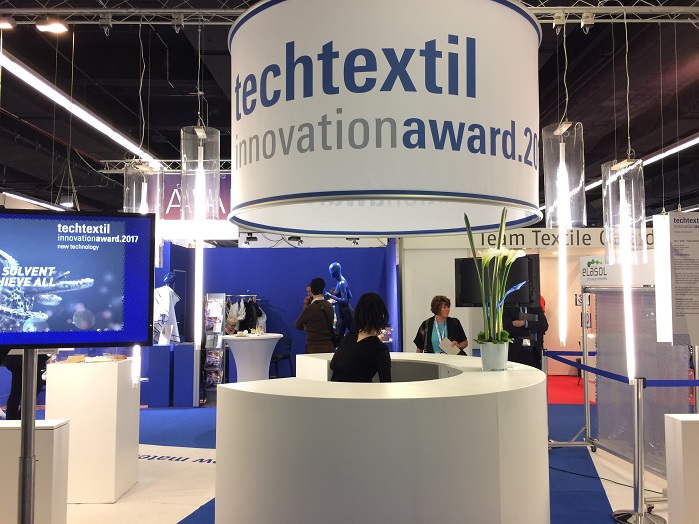
The creative and unique designs combined with functional and smart features and elegant technological solutions to create innovative products for future applications, resonating with the main theme of the event, dedicated to space and related aerospace technologies.
Textile innovations
In the New Application category, the winners were Centexbel, from Belgium, and Helmut Peterseim Strickwaren, from Mühlhausen. The intelligent knee brace from Centexbel supports patients during the rehabilitation phase. A textile sensor identifies the angle of the knee in real-time and informs the patient. It also offers personalised exercises and feedback via an app on the patient’s phone. With SEAL, Helmut Peterseim Strickwaren presents a basalt knitted fabric that protects maritime systems from environmental influences and cuts maintenance costs by up to 40%. The surface properties of the basalt prevent algae growth and are said to extend the possible dwell time in the water.
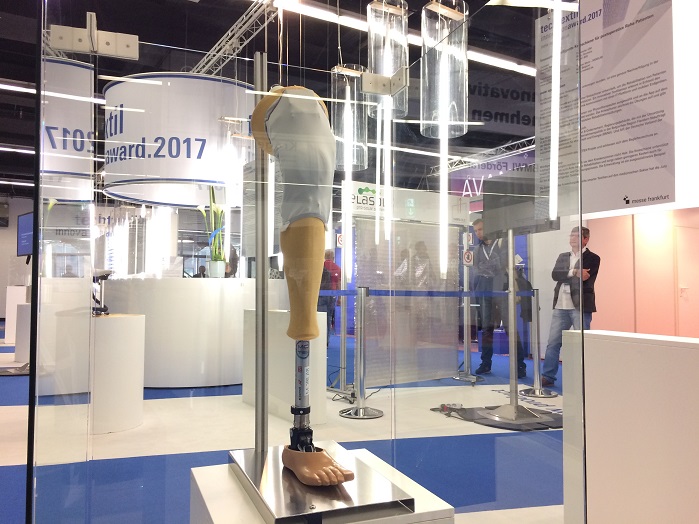
In the New Technology category, the Upper Franconian company of V. Fraas Solutions in Textile impressed the jury with its SITnet, a seamless, high-strength load-securing net distinguished by joining points for the belts, which are warp-knitted instead of sewn. Thus, the net is completely flat, homogenous, and capable of bearing higher loads than conventional products. Vetex NV also ranked among the winners in this category. Its OC2PUS ecological PU coating technology permits a polyurethane coating to be applied to flexible substrates, i.e., to functionalise textiles, without the use of solvents.
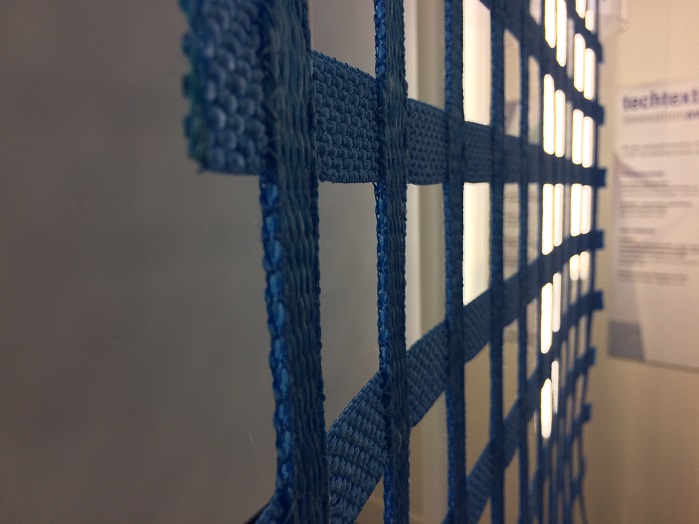
In the New Product category, the Leipzig-based start-up Texlock was chosen for its innovative, textile-based bicycle lock, which is light, flexible and does not scratch the bicycle’s paintwork thanks to its soft surface. Its multi-layered construction is said to offer a functional inner core, protecting tex-lock against cutting, striking and fire. Penn Textile Solutions was also selected for an Innovation Award in this category for Ombra-DLS, a shading net for use in facade construction and window installation. By expanding the net to a greater or lesser extent, the light admitted to a room or building can be modified according to requirements.
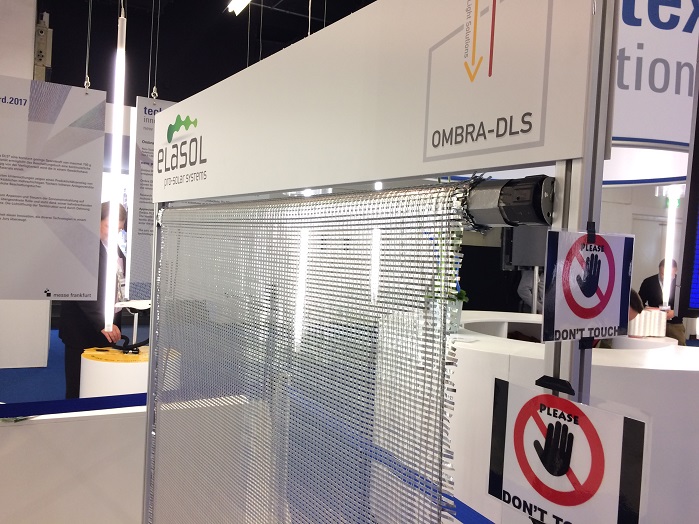
Two products were also singled out in the New Material category. The Institute of Textile Chemistry and Chemical Fibres (ITCF) Denkendorf received the award for Purcell, a sustainable composite made of pure cellulose, which is used as a high strength reinforcement fibre and also as a matrix component, a promising substitute to GFRP. Finally, Durafiber Technologies, from France, was chosen for an alkaline-resistant polyester HT yarn. “This development extends the application of high-tenacity polyester to areas where the fibre is subjected to severe alkaline conditions,” the jury commented.
Inspiring architecture
Techtextil also hosted the 14th edition of the student competition Textile Structures for New Building. An international jury of civil engineers and architects gave eight awards in various categories, honouring the ideas of students and young professionals on building with textiles. “Most contributions were inspiring, looking at functionalities from a fresh perspective, re-interpreting, showing creativity, changing the scale, integrating light, sound, new ideas for processes or methodologies, or showing refined poetic finishing,” commented Prof Dr-Ing Marijke Mollaert, Chairperson of the jury.
First prize in the macro-architecture category went to Katrin Fleischer, of the Technical University of Munich, for her Deployable Roof, a mobile canopy consisting of a folding support grid in the form of a barrel vault and an integrated membrane covering held under tension by bending-active slats. First prize in micro-architecture category went to Luani Costa, of the University of Minho in Portugal, for a smart adaptive façade element, which consists of triangular membrane elements that the user can open or close individually or altogether in response to the conditions prevailing.
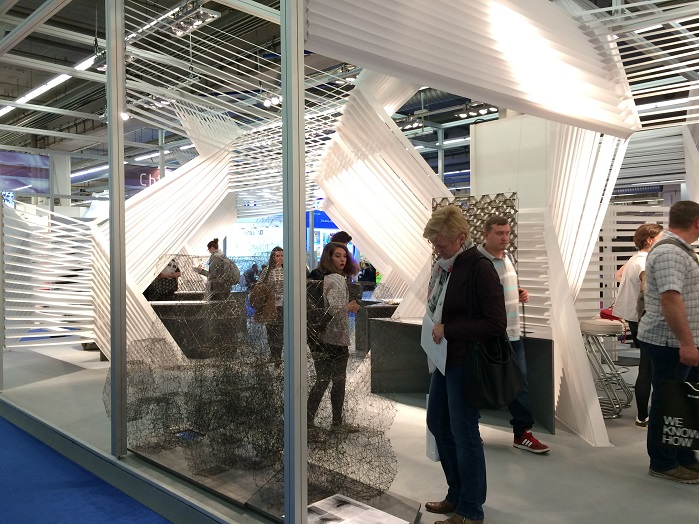
In the material innovation category, first prize went to Natascha Unger and Idalene Rapp, of the Berlin-Weissensee Academy of Arts, for their Stone Web – a structure made of polylines that are drawn freely within the design space following the force paths. According to the jury, the project illustrates is a pioneering contribution to the use of fibre-based structures in lightweight construction.
In the composites and hybrid structures category, Anne-Kathrin Kühner took first place with her idea for a concrete textile – a textile tube filled with high-performance concrete. The resulting filament is flexible and can be shaped immediately after the tube has been filled with concrete to create woven, knitted or knotted textiles. The textile sleeves resist tensile force, while the hardened concrete inside the sleeves resists compression force.
Future Textiles Awards
WTiN hosted another edition of the Future Textiles Awards, originally launched in 2014, in order to recognise the outstanding achievements of companies and individuals across the technical textiles sector. The event was held at The Westin Grand Frankfurt on 10 May 2017, featuring 16 award categories.
Elizabeth Whelan Design took Launch of the Year, one of two top prizes, for its Tegris-Lite Tumi luggage, which merges ballistic nylon with Tegris – a carbon fibre-like polypropylene tape manufactured by Milliken to achieve a lightweight yet strong product. Kunal Mankodiya was named Innovator of the Year for Woven-IoT: Smart Textile Internet-of-Things for Precision Telemedicine, which the judges noted offers a range of practical home-monitoring solutions for major medical conditions, in patients for whom hospital visits are problematical.
Sensoria was recognised as the Best Start-up Company, for its Sensoria Development Kit (SDK), a platform comprising proprietary textile sensors, electronics, mobile application and cloud infrastructure for the development of smart garment solutions. Meanwhile, Inuheat Group won the Best Product – Clothing Textiles category for its flexible and conductive yarn for actively-heated clothing; and the Ground Breaking Partnership prize for its collaboration with various clothing brands on its Wearable Heating Platform.
Innovative Apparel Public Award
Julia Gross-Müller of Hochschule Trier won the first prize of the Innovative Apparel Public Award. Entitled World Folklore, her model was chosen as the visitors’ favourite at the Innovative Apparel Show during Techtextil and Texprocess 2017. The second prize went to Portugal, to Mariana Almeida, of ESAD College of Art and Design. The winner of the third prize was Eleonara Beni of Accademia Italiana in Florence.
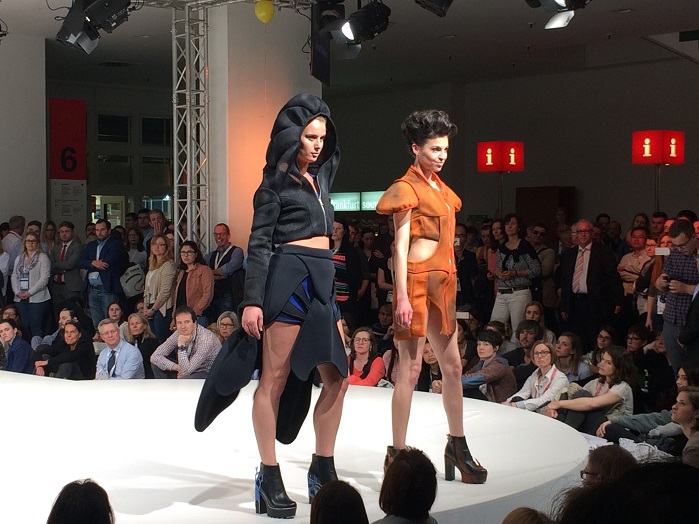
The Innovative Apparel Show during Techtextil and Texprocess this year presented new garment textiles and innovative processing technologies in the form of a fashion show. Students of four international design universities showcased their innovations.
This year, the universities were Esmod from Paris, ESAD College of Art and Design from Portugal, Accademia Italiana, Florence, and Hochschule Trier. The award-winning projects were chosen by the visitors of Techtextil and Texprocess, who had the chance to vote for the models they liked the best.

 info@topweaving.com
info@topweaving.com



View More(Total0)Comment lists